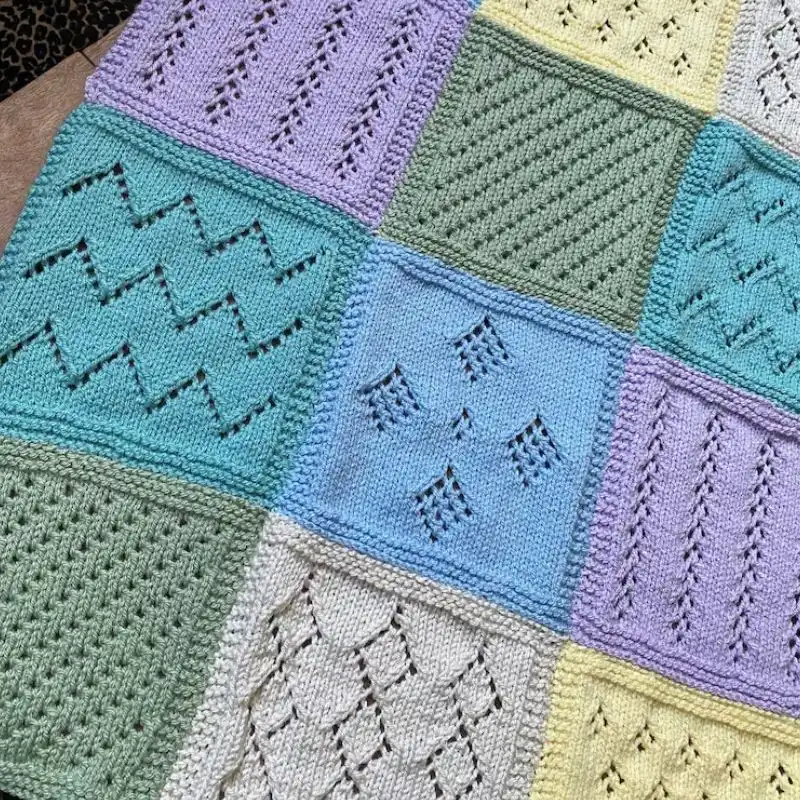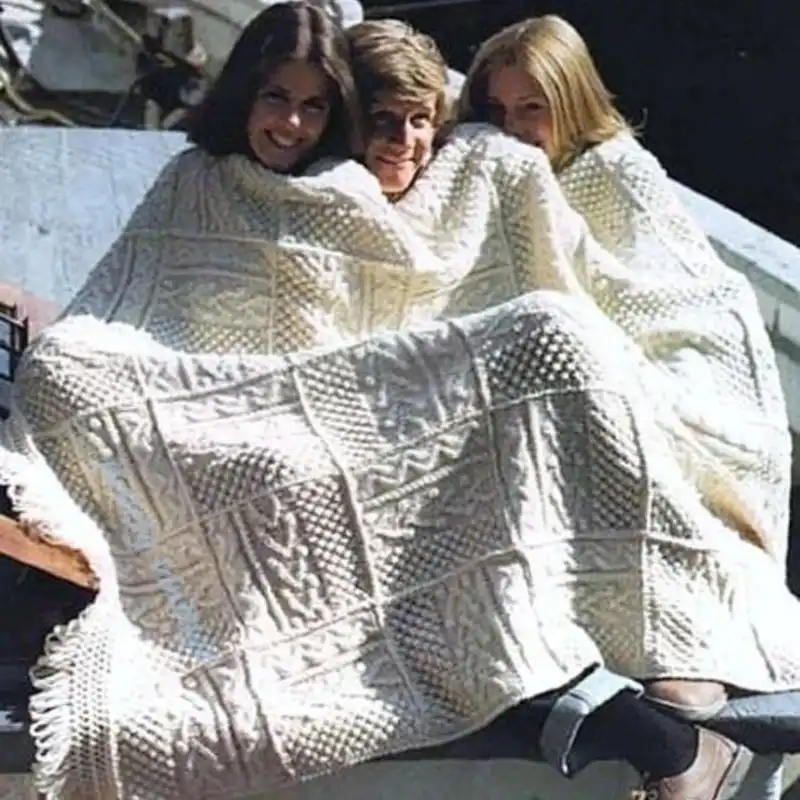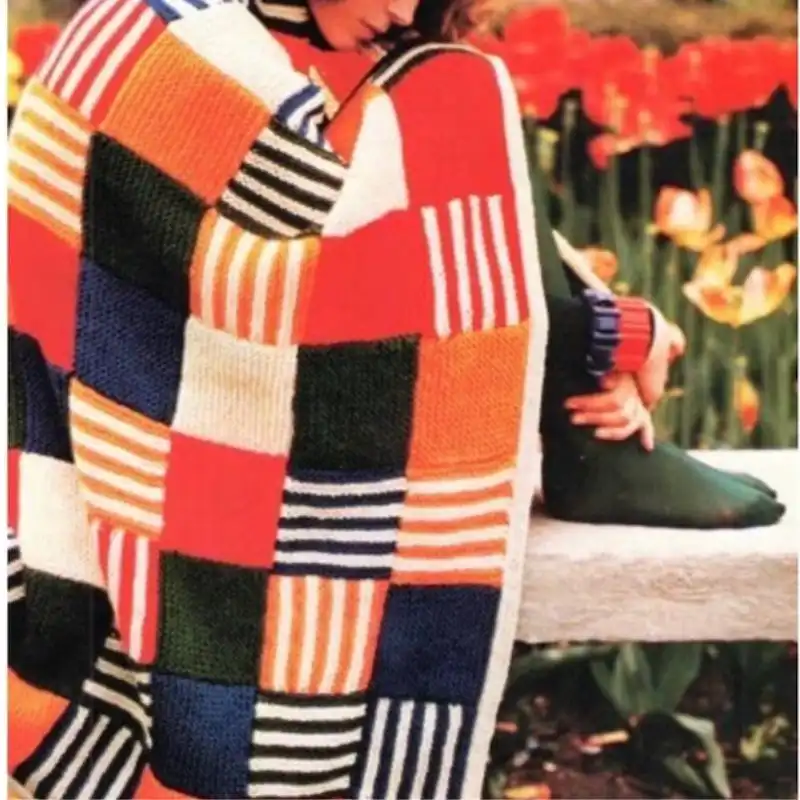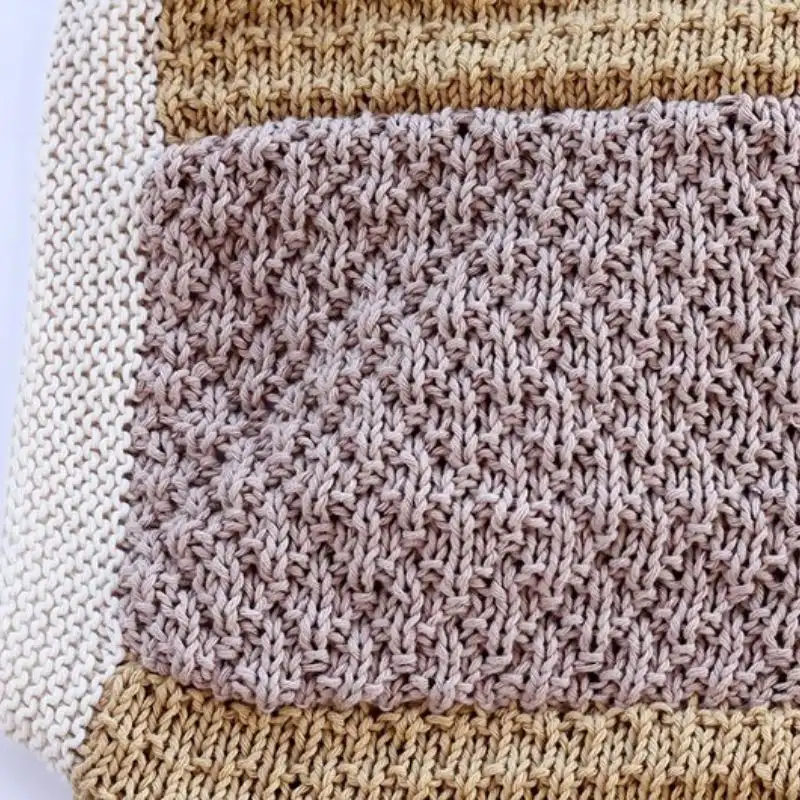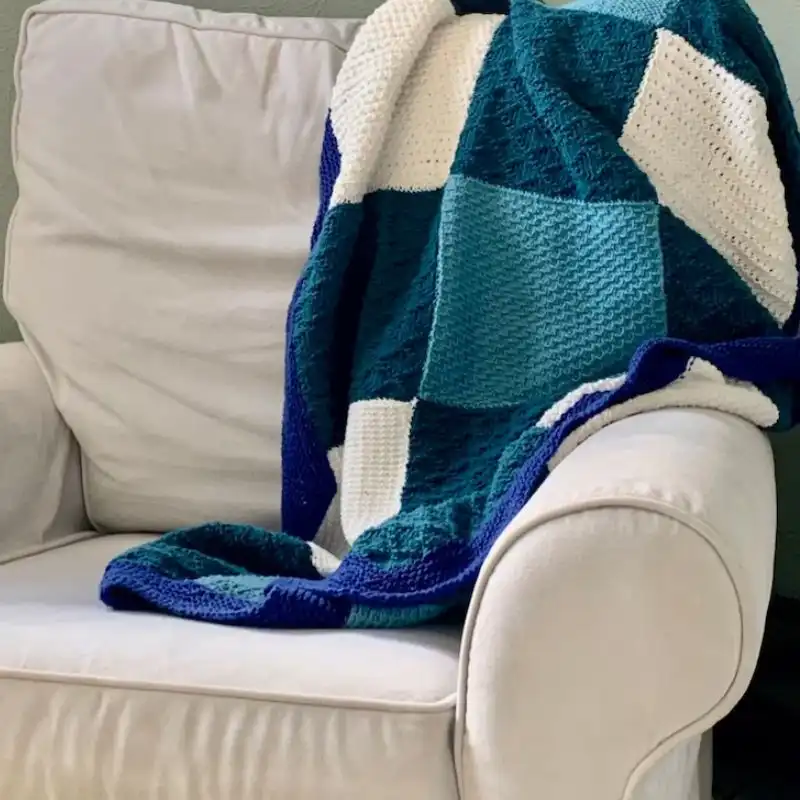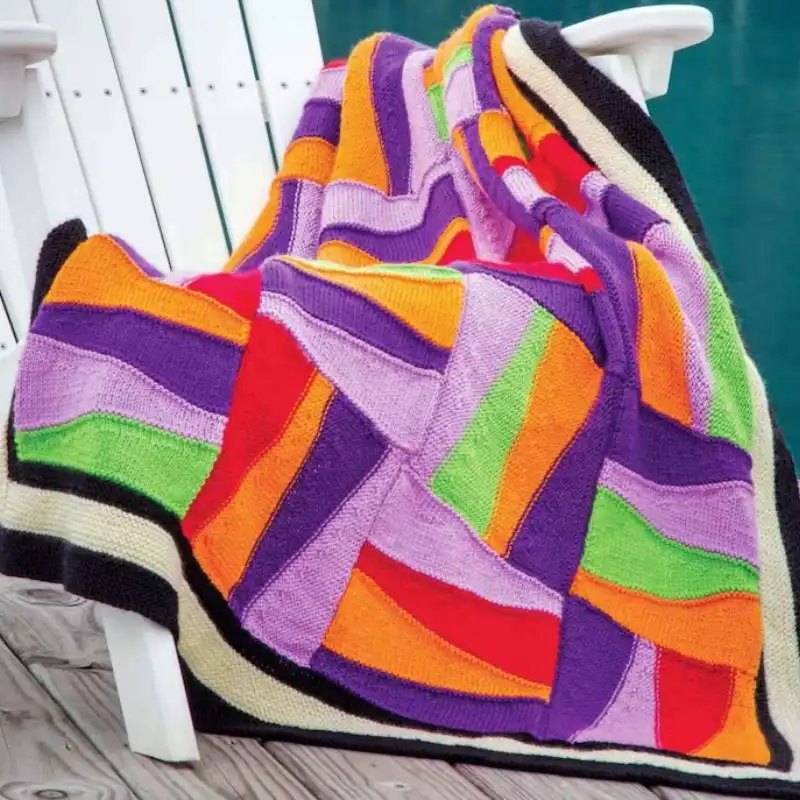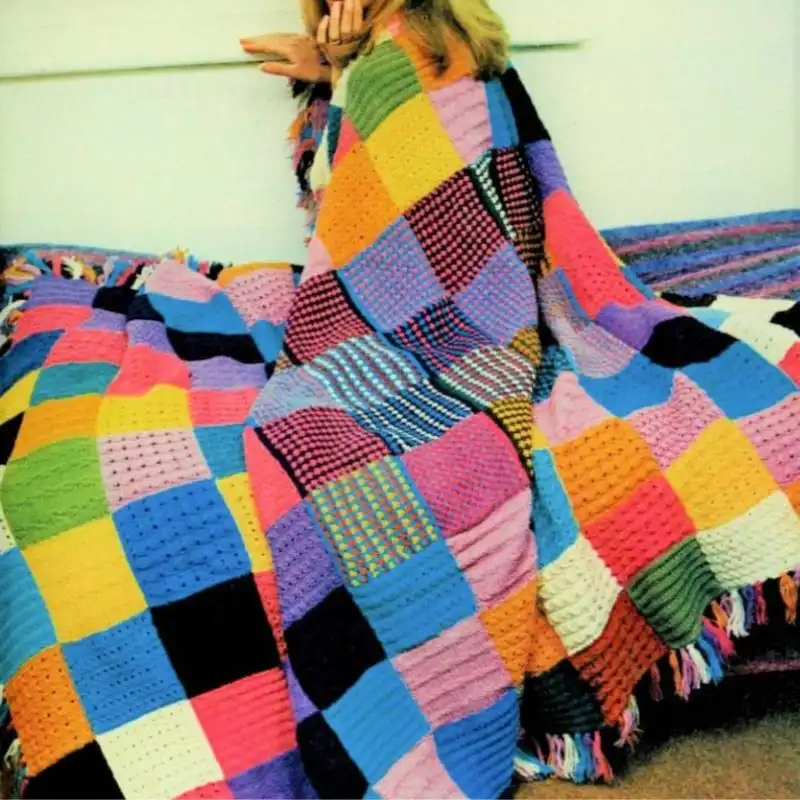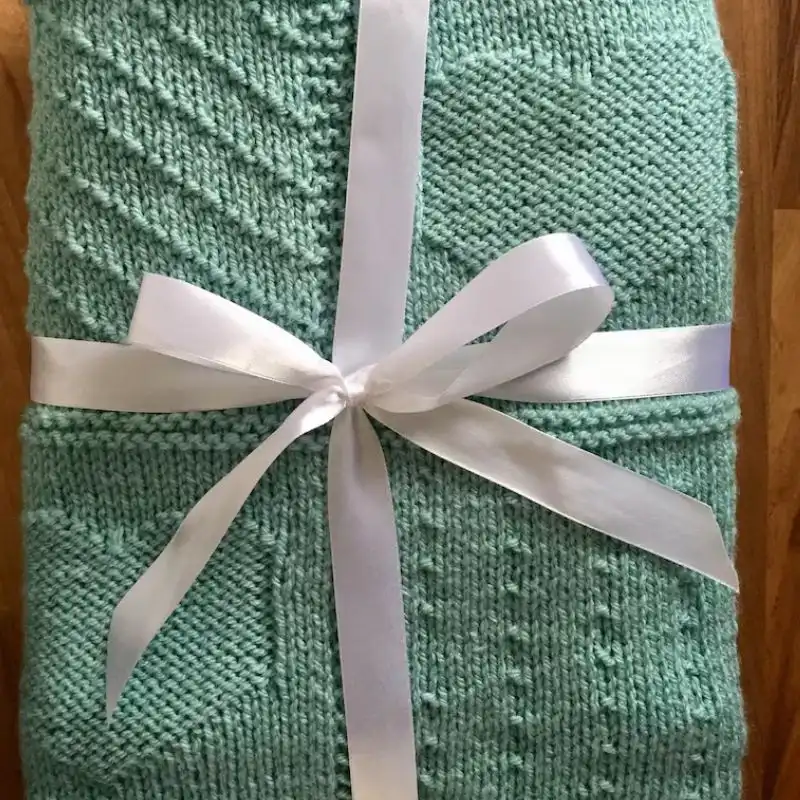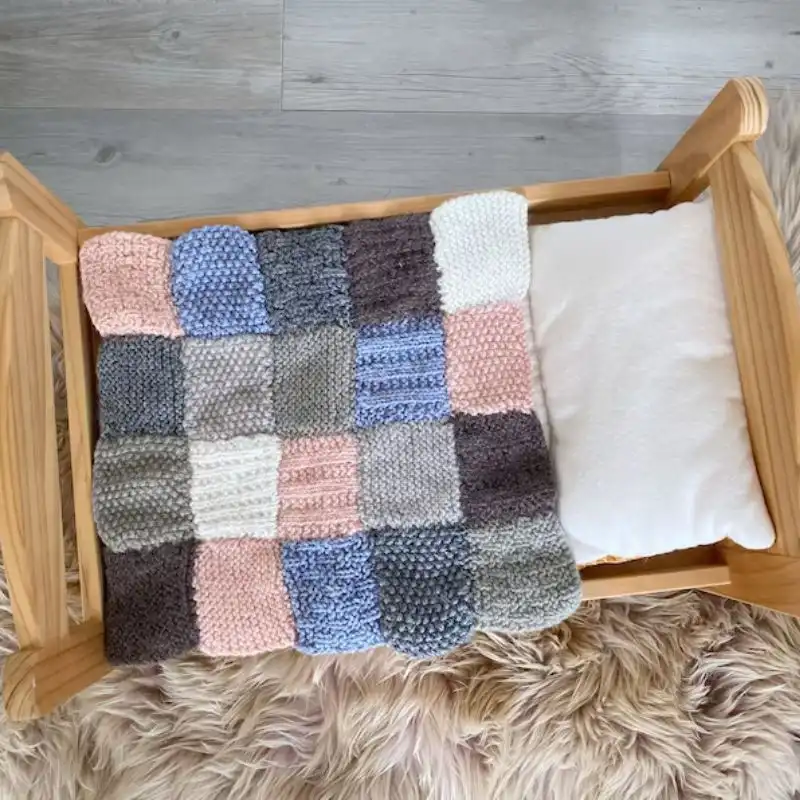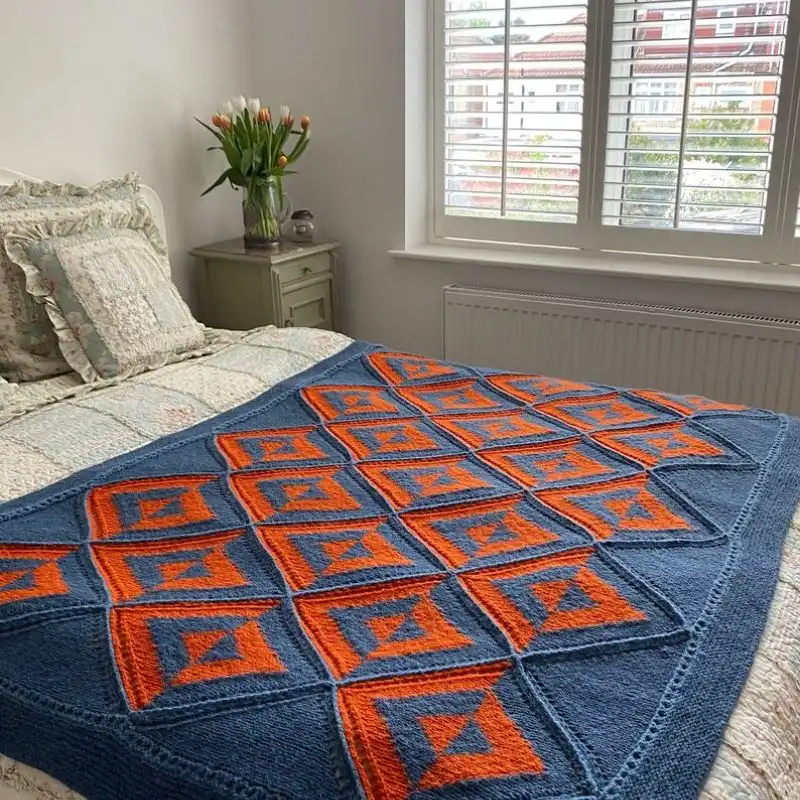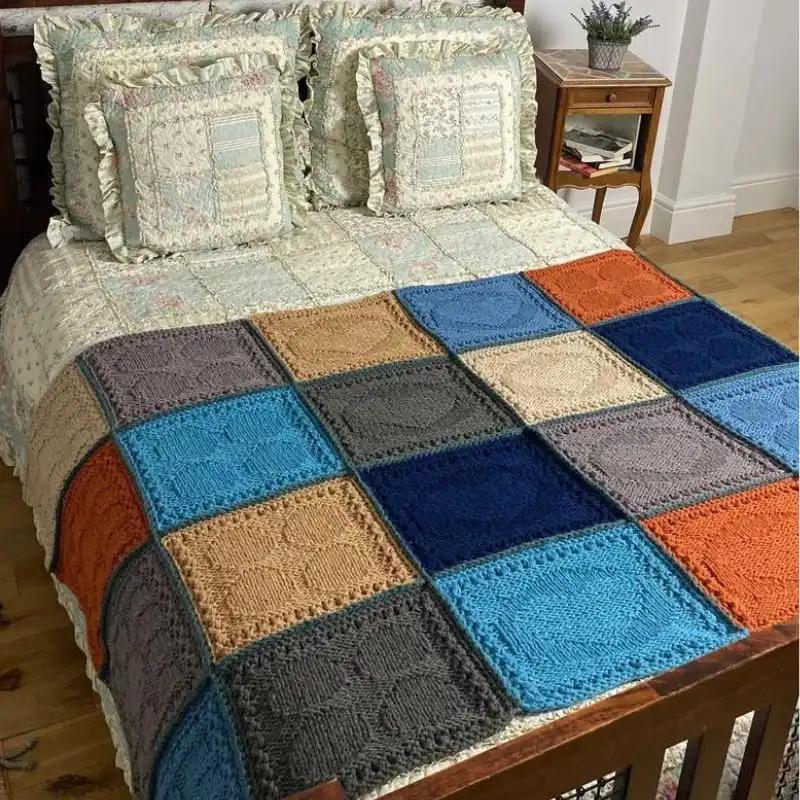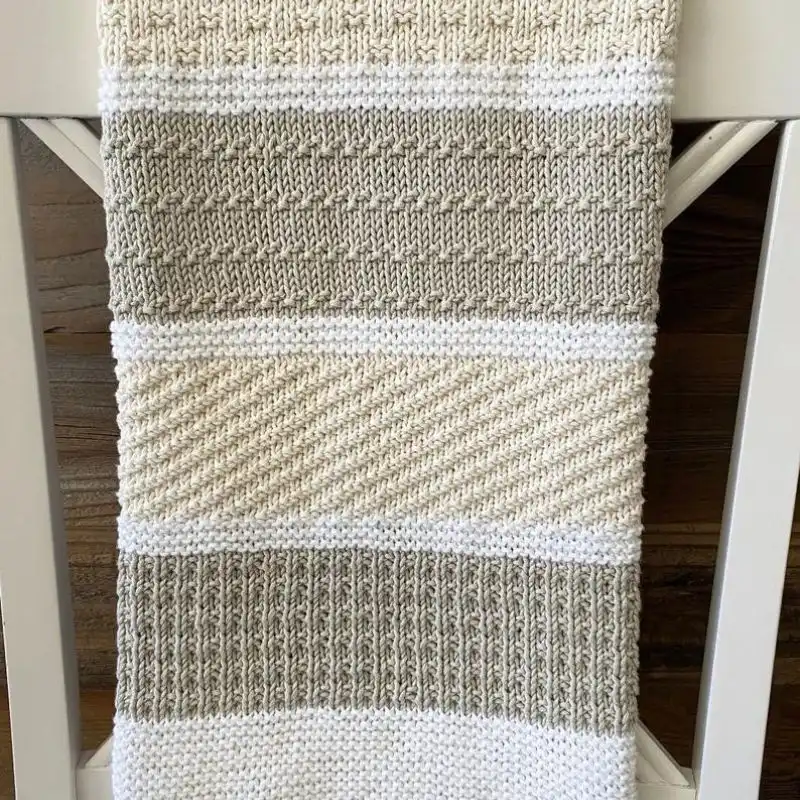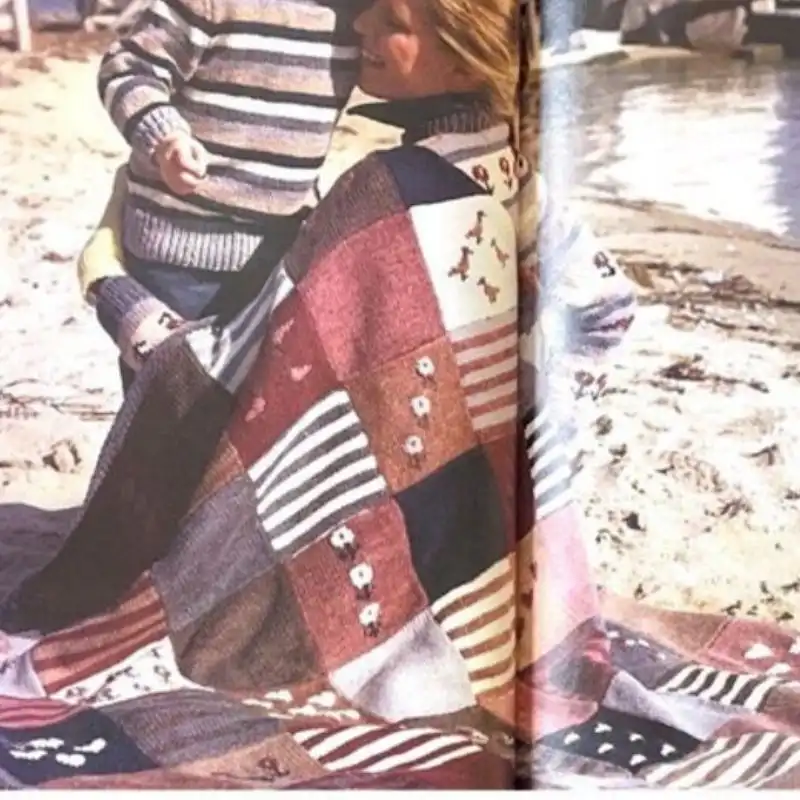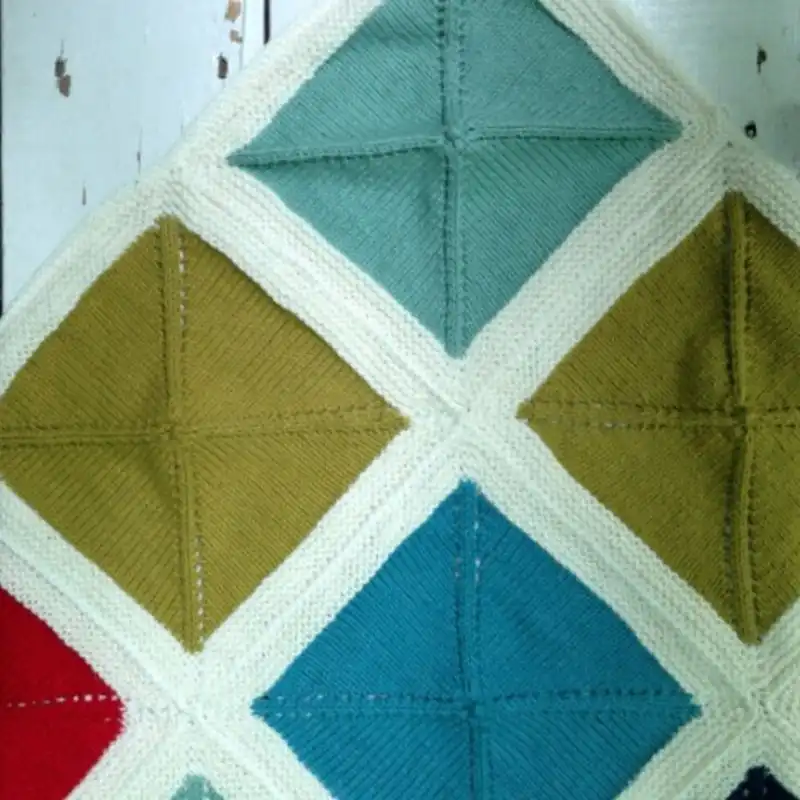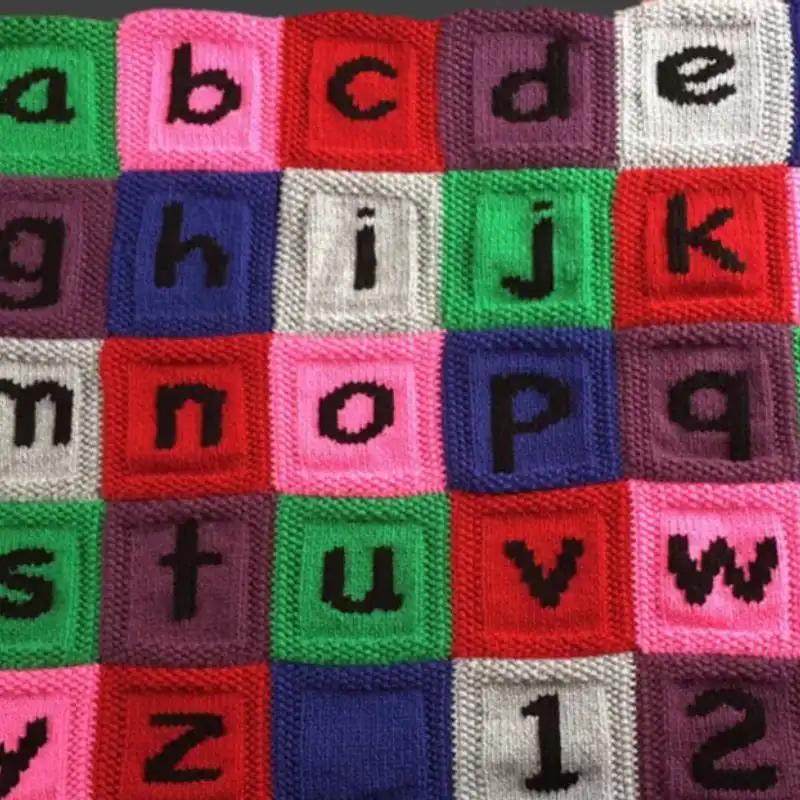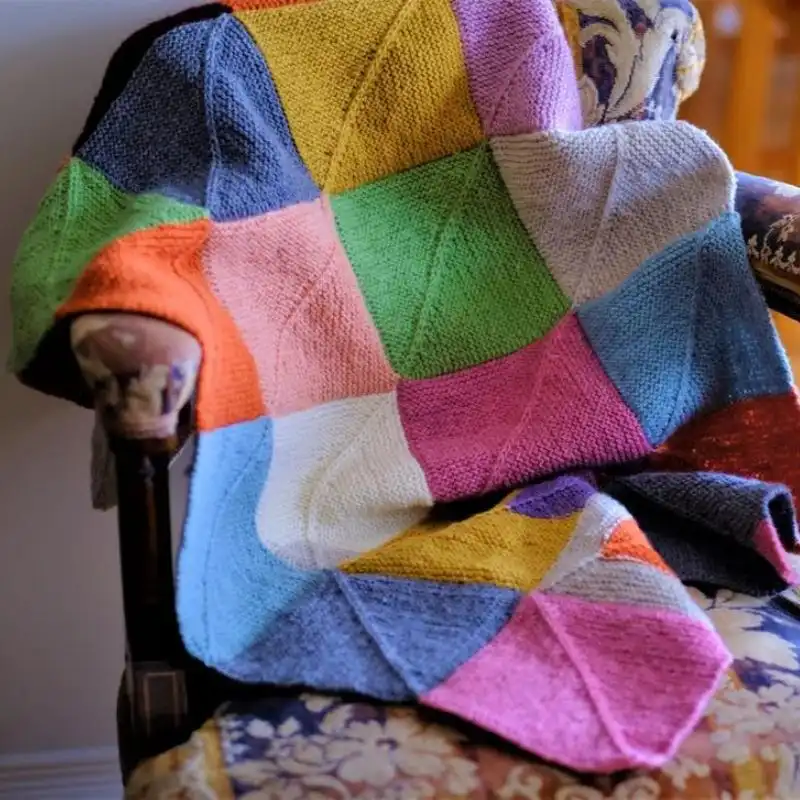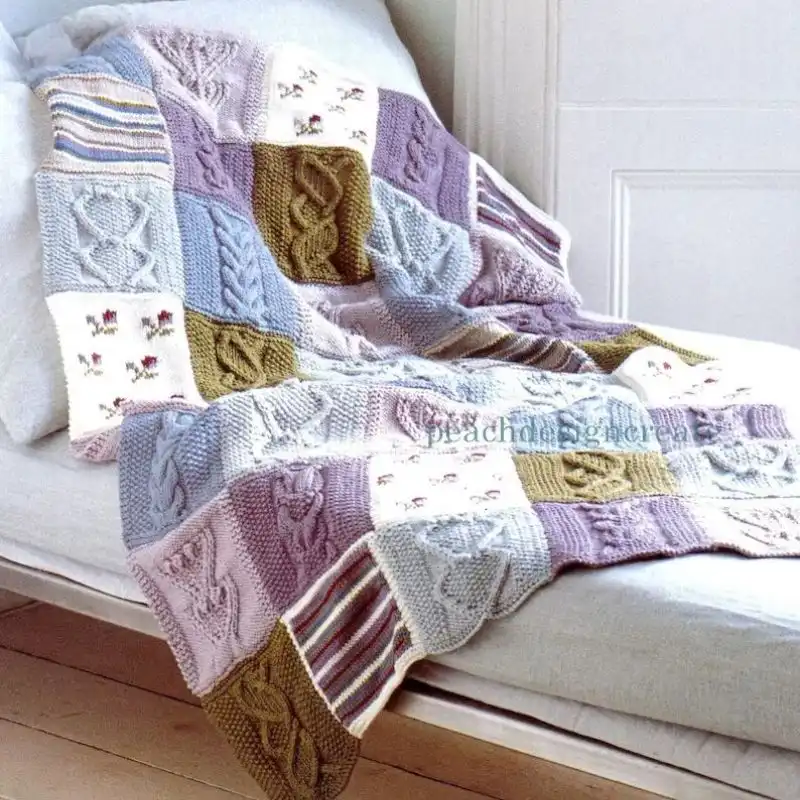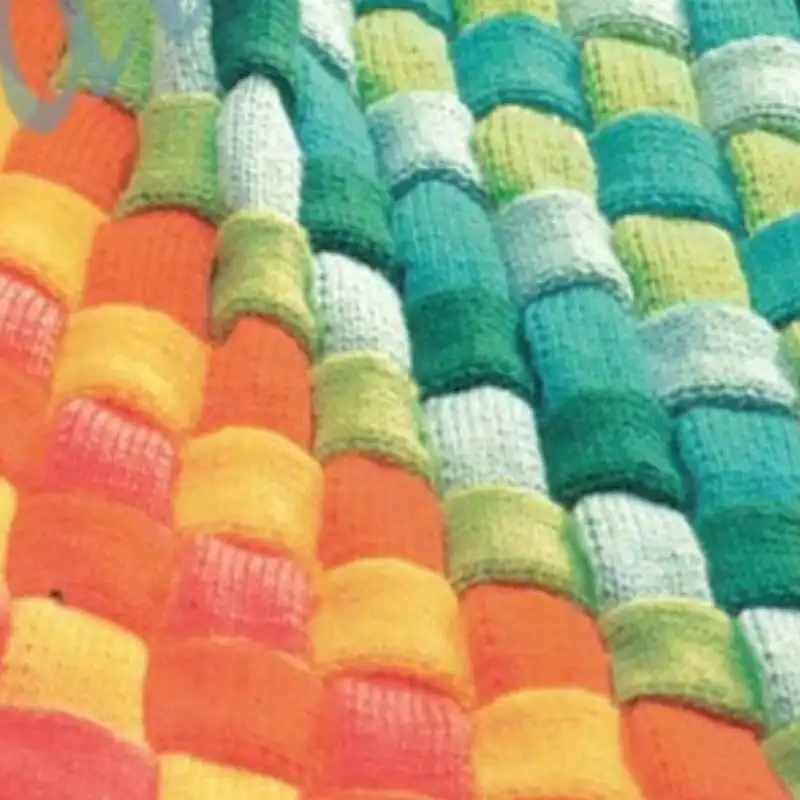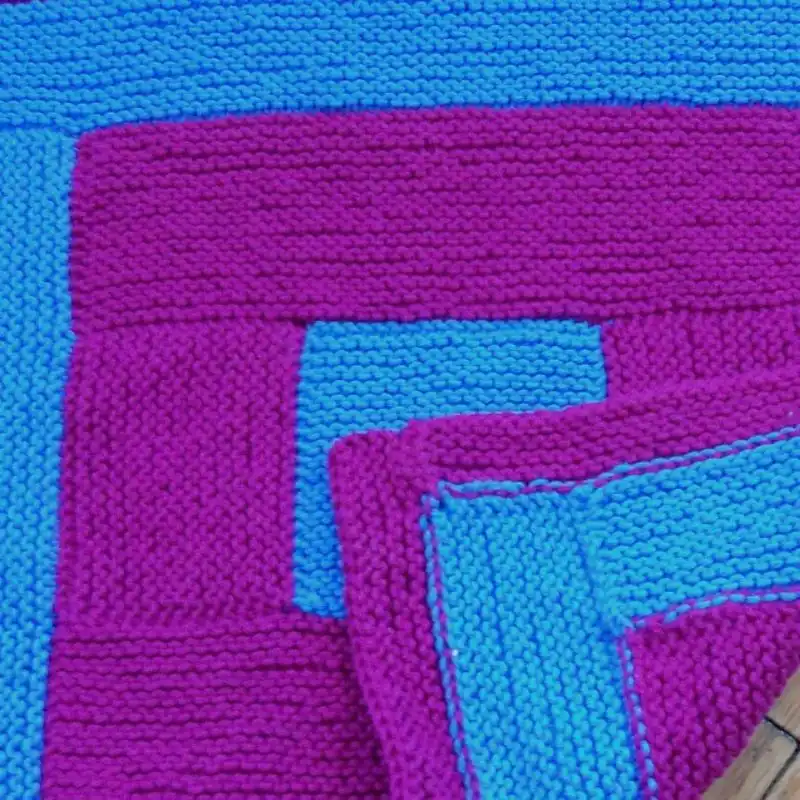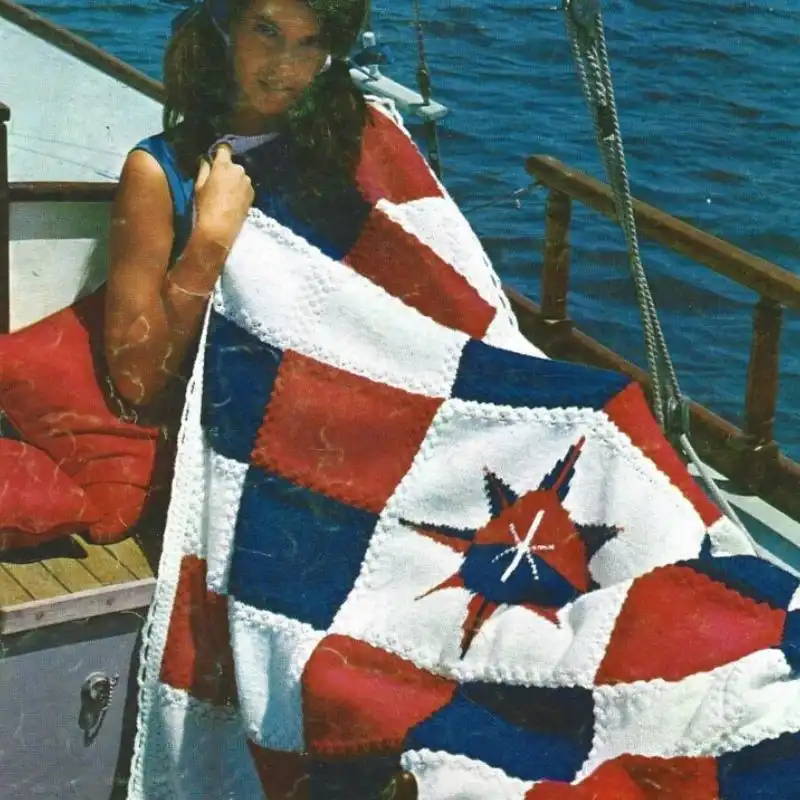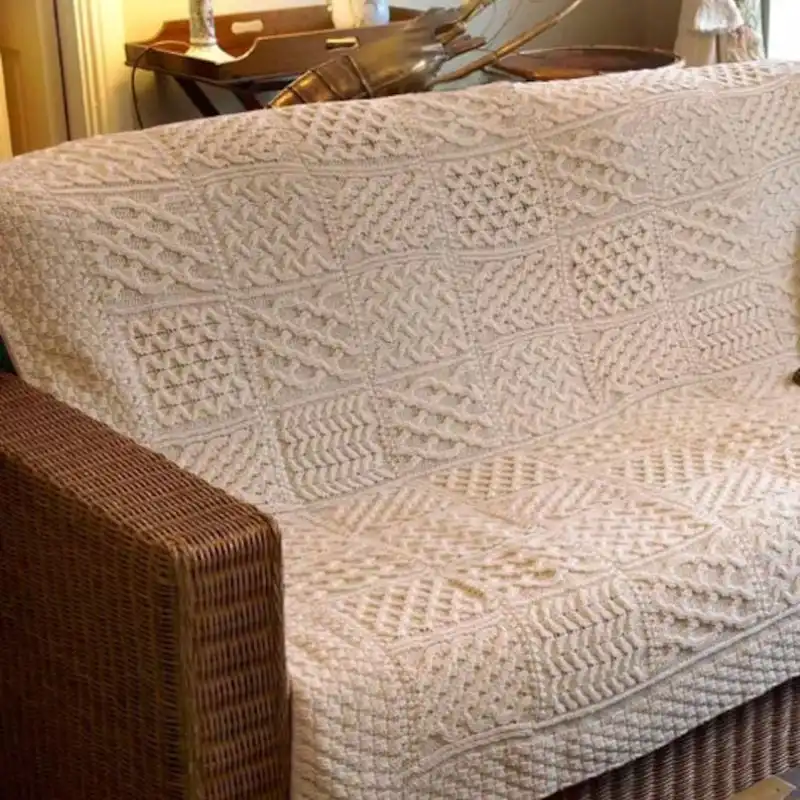Have you ever found yourself bundled under a dull, store-bought blanket, dreaming of something cozier and more personal? I’m here to turn that dream into a reality. As an expert knitter, I’ve discovered the best way to infuse warmth and personality into your home is through patchwork blanket knitting.

It’s one of the best ways to express creativity and comfort simultaneously. In this post, I’ll introduce you to 30 Unique Patchwork Blanket Knitting Patterns, each meticulously crafted to knit your way to coziness.
What is the most significant advantage of these patterns? They are designed to be beautiful and functional, ensuring you’ll never be in a dreary decor dilemma again.
The most significant advantage lies in their simplicity – one of the easiest and most effective ways to resolve the issue of mundane blankets.
With options ranging from beginner-friendly to more intricate designs, my top picks will surely be your best bet for a great knitting adventure. All you need are your needles, yarn, and a dash of creativity to solve the problem of bland blankets.
Let’s embark on a whimsical journey of knitting, where each stitch brings a great way to add a unique touch to your living space. These patterns aren’t just a great option; they’re the easiest way to transform your living space, one cozy patch at a time.
What Is A Patchwork Blanket?
As a knitter, I find creating a patchwork blanket a journey of art and comfort. I knit individual squares, each dancing with its unique pattern or design, and then lovingly sew them together.
It’s like weaving a tapestry of artistic expression, where each square tells its story. These blankets, to me, are more than just cozy creations; they become cherished heirlooms and make wonderful handmade gifts for my loved ones.
What excites me most about patchwork blankets is the opportunity to explore various techniques and styles in a single project. I dabble in everything from simple garter stitch and stockinette stitch squares to more intricate Fair Isle or lace designs.
Their modular nature, assembled from smaller pieces, makes them perfect for on-the-go knitting. It’s also a fantastic way to use leftover yarn from my stash, giving life to every last strand. Each patchwork blanket I create is a mosaic of creativity and warmth stitched together with love and care.
Benefits Of Knitting Patchwork Blanket
Knitting a patchwork blanket offers numerous practical and psychological benefits, making it a rewarding project for knitters of all levels. Here are some of the key benefits:
- Creativity and Personalization: Each square in a patchwork blanket can uniquely express creativity. You can experiment with different colors, patterns, and textures, creating a truly personalized and unique creation.
- Skill Development: Patchwork blankets are excellent for honing knitting skills. They offer the opportunity to practice and master a variety of stitches and techniques, from basic garter and stockinette stitches to more complex patterns like Fair Isle or lace.
- Stress Relief and Mental Wellness: Like many forms of knitting, working on a patchwork blanket can be incredibly soothing and meditative. The repetitive motion of the needles and the focus required can help reduce stress and promote a sense of calm.
- Portability: Since patchwork blankets comprise smaller individual squares, they’re more portable than larger knitting projects. It makes them ideal for knitting on the go.
- Resourcefulness and Sustainability: Patchwork blankets are great for using leftover yarn and reducing waste. It makes them an eco-friendly project, as you can repurpose scraps of yarn that might otherwise be thrown away.
- Sense of Accomplishment: Completing a patchwork blanket, with its many components and intricate design, offers a significant sense of accomplishment. Seeing the individual squares come together into a cohesive whole is exceptionally satisfying.
- Versatility in Design: You can easily adjust the size of your blanket by adding or removing squares, making it a versatile project that can be tailored to your needs or preferences.
- Therapeutic for Physical Health: Knitting has been shown to improve motor skills and help maintain finger dexterity and hand-eye coordination, which is especially beneficial as one age.
- Social Engagement: Joining a knitting group or community project to create patchwork blankets can provide a sense of community and connection, offering social benefits alongside the joy of knitting.
- Heirloom Quality: A well-crafted patchwork blanket can last for generations, becoming a cherished heirloom with personal and sentimental value.
RELATED: 33 Dress Knitting Patterns Create Your Fashion Masterpieces
Various Stitches To Knit Patchwork Blanket
Creating a patchwork blanket allows you to delve into various knitting stitches, each adding its unique texture and pattern to the overall design. Here are some popular stitches you might consider for your patchwork blanket, along with brief explanations:
- Garter Stitch: This is one of the simplest stitches, perfect for beginners. It’s created by knitting every row, resulting in a textured, ridged fabric that lies flat and is the same on both sides.
- Stockinette Stitch: This classic stitch is achieved by knitting one row and then purling the next. It creates a smooth, ‘V-shaped pattern on the front, with a bumpy texture on the back. However, it tends to curl at the edges.
- Seed Stitch: A textured pattern made by alternating knit and purl stitches within each row and from row to row. It creates a bumpy texture that lies flat and adds interest to your blanket.
- Moss Stitch (or Double Seed Stitch): Similar to the seed stitch, but with two knit stitches followed by two purl stitches, repeated across the row and for two rows, then alternated. It creates a more checkerboard-like texture.
- Cable Stitch: This stitch involves crossing a group of stitches over each other to create a twisted, rope-like pattern. It’s more advanced but adds a beautiful, three-dimensional texture to the blanket.
- Rib Stitch: Created by alternating knit and purl stitches within the same row. Ribbing is commonly used for edges because it’s stretchy and lies flat.
- Lace Stitch: Various lace patterns involve yarn overs and decreases to create open, airy designs. Lace knitting can be complex but adds a delicate and intricate element to your blanket.
- Basketweave Stitch: This stitch creates a texture that looks like a woven basket, using blocks of knit and purl stitches. It’s a great way to add depth to your blanket’s design.
- Chevron Stitch: This involves increases and decreases to create a zigzag pattern. It’s visually striking and can create exciting colorwork in your blanket.
- Fair Isle (or Stranded Colorwork): This technique uses two or more colors in a row to create patterns. It’s a bit more complex but allows for vibrant, multicolored designs.
- Intarsia: This technique is used for creating large blocks of color in your knitting, such as a heart or a star, by introducing separate balls of yarn for each color area.
Essentials Tools & Materials
Knitting a patchwork blanket requires various tools and materials to ensure the process is smooth and enjoyable. Here’s a list of essential items you’ll need:
Common Abbreviations For Knitting
When knitting a patchwork blanket, you’ll come across various standard abbreviations in patterns. These abbreviations are used to simplify and standardize knitting instructions. Here’s a list of some of the most common ones you might encounter:
- CO: Cast On – To begin by creating the initial stitches on the needle.
- BO: Bind Off – To finish by securing the last row of stitches so they don’t unravel.
- K: Knit – The basic knitting stitch.
- P: Purl – The reverse of the knit stitch.
- St(s): Stitch(es) – The fundamental unit of knitting.
- K2tog: Knit Two Together – A decrease technique where two stitches are knit together.
- P2tog: Purl Two Together – Similar to K2tog, but with purl stitches.
- YO: Yarn Over – An increase that involves wrapping the yarn over the needle to create a new stitch and a hole, commonly used in lace patterns.
- SSK: Slip, Slip, Knit – A decrease method where you slip two stitches as if to knit, then knit them together through the back loop.
- Sl1: Slip 1 Stitch – To move one stitch from the left needle to the right needle without knitting it.
- RS: Right Side – The front or public side of the fabric.
- WS: Wrong Side – The back or private side of the fabric.
- PM: Place Marker – To put a stitch marker on the needle.
- SM: Slip Marker – Move the stitch marker from the left needle to the right.
- Rep: Repeat – To do the same set of instructions again.
- M1: Make One – An increase by lifting the running thread between two stitches and knitting it.
- Rnd(s): Round(s) – Used in circular knitting.
- Tbl: Through Back Loop – To knit or purl a stitch through its back loop instead of the front, twisting the stitch.
- Psso: Pass Slipped Stitch Over – Used in decreases, where a slipped stitch is passed over a knit stitch and off the needle.
- SKP: Slip, Knit, Pass – A decrease method similar to SSK.
Which yarn is best to knit a Patchwork Blanket?
When choosing the best yarn for knitting a patchwork blanket, I’ve found that it largely depends on the purpose of the blanket, who it’s for, and personal preference. Here are my thoughts on various yarns based on my experience:
- Wool: Wool is a classic blanket choice due to its warmth and durability. It’s great for cozy winter blankets. However, it can be a bit scratchy for some, requiring careful washing to avoid shrinking.
- Cotton: I love using cotton for baby blankets or summer throws because it’s soft, hypoallergenic, and breathable. It’s also easy to wash, making it practical for frequent use. However, it doesn’t have the same elasticity as wool, which can affect the tension in your knitting.
- Acrylic: Acrylic yarn is popular due to its affordability and wide range of colors. It’s easy to care for and suitable for everyday blankets. However, it’s less breathable than natural fibers and can feel less luxurious.
- Superwash Wool: This wool has been treated to make it machine washable. It combines the warmth and quality of wool with easy care and convenience. It’s an excellent option for children’s blankets or gifts.
- Alpaca: Alpaca yarn is warmer than wool and incredibly soft. It’s hypoallergenic and a luxurious choice for a special blanket. However, it can be more expensive and might require careful washing.
- Blends: Yarn blends, like wool-acrylic or cotton-bamboo, offer the best of both worlds. These can be tailored for warmth, softness, and washability. Blends are versatile and can cater to specific needs like durability or ease of care.
- Chunky Yarn: For a quick knit, I sometimes use chunky yarn. It works up fast and makes a cozy, thick blanket. However, these blankets can be pretty heavy and might not be as detailed in their stitch work due to the larger yarn size.
- Bamboo: Bamboo yarn is soft, with a beautiful sheen, and is environmentally friendly. It’s great for a lightweight, hypoallergenic blanket, although it’s not as warm as other fibers.
How Much Yarn Do I Need To Knit A Patchwork Blanket?
Determining how much yarn I need for a patchwork blanket depends on several factors:
- The size of the blanket
- The gauge of my knitting
- The size of the needles
- The weight of the yarn
Generally, I usually estimate around 1200-2000 yards of medium-weight yarn for an average-sized throw blanket. If I’m using bulkier yarn, I might need less; more might be required for finer yarn.
The beauty of a patchwork blanket is its flexibility. I can start with a certain amount of yarn and simply add more squares to enlarge it or stop earlier for a smaller version.
Buying more yarn than calculated is always a good idea, as it accounts for gauge variations or pattern changes. Plus, it ensures I have enough if the same dye lot is hard to find later.
Understand Knitting Stitches And Techniques
Understanding knitting stitches and techniques initially seemed daunting, but practice and patience were key. I started by familiarizing myself with basic stitches like knit and purl, which are the foundation of most patterns.
Then, I learned variations and combinations of these stitches, such as ribbing or seed stitches. Techniques like increasing, decreasing, and yarnovers added complexity to my projects. I found that following written instructions alongside watching tutorial videos was immensely helpful.
Tackling one new stitch or technique at a time, integrating it into a small project, and repeating it until I felt comfortable was my strategy for mastering knitting.
Is It Beginner Friendly?
From my perspective, knitting a patchwork blanket can be beginner-friendly, but it largely depends on the complexity of the individual squares and the overall design.
The beauty of a patchwork blanket is its modular nature. Beginners can start with simple square designs, using basic stitches like the knit and purl stitch. It makes for an excellent project for practicing and consolidating basic skills.
As one becomes more comfortable with knitting, more intricate designs and techniques like cable stitches or lace patterns can be incorporated. This flexibility allows the difficulty level to be tailored to the knitter’s skill set.
However, assembling the squares and achieving consistent tension across different patterns can be challenging for beginners. It requires some planning and precision. The seaming process, joining all the squares together, also requires careful attention.
How do you cast on for the patchwork blanket, and how many stitches?
Casting on for a patchwork blanket depends on the size of the squares you plan to knit and the gauge of your yarn and needles. Here’s a general approach:
- Determine the Size of Your Squares: First, decide on the size of each square. Standard square sizes range from 4×4 inches to 12×12 inches for a patchwork blanket.
- Gauge Swatch: Knit a gauge swatch with your chosen yarn and needles. It means knitting a small sample, typically in stockinette stitch, and measuring how many stitches and rows per inch you get.
- Calculate Stitches: Once you know your gauge, calculate the number of stitches to cast on. For example, if your gauge is 5 stitches per inch and you want a 6-inch square, you’ll need to cast on 30 stitches (5 stitches/inch x 6 inches).
- Casting On: For casting on, I usually use the long-tail cast-on method for its flexibility and neat edge, but you can use any method you’re comfortable with. Make sure your cast-on is tight enough; otherwise, it can distort the edges of your squares.
- Start Knitting: After casting on, you can begin knitting according to the pattern you’ve chosen for your square.
Knitting Techniques
Casting On And Off
To start your patchwork blanket journey, you’ll first need to cast on the stitches for your pieces. Select the appropriate number of stitches for the width of your details. For example, cast on 30 stitches for 10-inch-wide pieces or 60 stitches for 20-inch-wide pieces. Your knitting adventure has just begun!
Next up, in the world of knitting, casting off is the magical process of finishing your pieces. When you reach the designated lengths for your squares, boldly cast off to seal your stitches and complete each patch. Whisk away those loose ends by weaving them in, and you’re ready for the next enchanting step.
Color Changes
Now that you’ve summoned the spirits of casting on and off, it’s time to add a splash of color to your patchwork blanket. Embrace the power of color changes to create enchanting combinations with your yarn. Switch between colors as needed according to the pattern when knitting each piece. The kaleidoscope of hues will bring your patchwork blanket to life!
Stitching
Last, let’s dive into the captivating world of stitches. For your patchwork blanket, focus on the ever-reliable and charming garter stitch. This simple stitch adds texture and forms a sturdy fabric for your blanket. As you knit the individual pieces, your deft hands will weave the tale of your patchwork blanket’s journey.
RELATED: 22 Cable Knitting Patterns Discovering Intricate Knit Designs
How To Knit A Beginner-Friendly Patchwork Blanket? – Step By Step Instructions
Knitting a beginner-friendly patchwork blanket can be a rewarding project. Here’s a step-by-step guide to get you started:
Skill Level
Easy
Materials
- Choose a medium-weight yarn (like worsted weight) for ease of handling.
- Knitting needles US size 7-9 (4.5-5.5 mm) for worsted weight yarn.
- Scissors
- Tapestry Needle
- Measuring Tape
Instructions
Step 1: Make A Gauge Swatch
- Knit a 4×4 inch swatch to determine your stitches per inch. It helps calculate how many stitches to cast on each square.
Step 2: Decide On A Square Size
- A 6×6 inch square is a manageable size for beginners.
Step 3: Calculate Stitches To Cast On
- If your gauge is 5 stitches per inch and you want a 6-inch square, cast on 30 stitches (5 stitches/inch x 6 inches = 30 stitches).
Step 4: Cast On
- Use a simple cast-on method like the long-tail cast-on.
Step 5: Knit The Squares
- Option 1: Knit all rows (garter stitch) until your square measures the desired size.
- Option 2: Knit one row purl the next (stockinette stitch), but remember that stockinette curls at the edges.
- Tip: Keep track of your rows to ensure each square is the same size.
Step 6: Bind Off
- Bind off loosely once your square reaches the desired size to avoid a tight edge.
Step 7: Repeat For More Squares
- Continue knitting squares until you have enough to reach your desired blanket size. It could be anywhere from 20 squares for a small lap blanket to 100 or more for a larger one.
Step 8: Block Your Squares
- Wet or steam block your squares to make them uniform in size. Lay them flat, pin them to size, and let them dry.
Step 9: Arrange Your Squares
- Lay out your squares in a pattern you like. It is where you can get creative with colors and layout.
Step 10: Sew Squares Together
- Use a tapestry needle and yarn to sew the squares together. You can use the mattress stitch for a neat seam.
Step 11: Weave In Ends
- Once all squares are sewn together, weave in any loose ends with your tapestry needle.
Step 12: Add A Border (Optional)
- For a finished look, pick up stitches around the edge of the blanket and knit a few rows in a garter stitch.
Step 13: Final Blocking
- Block the entire piece again once your blanket is complete for a professional finish.
30 Patchwork Blanket Knitting Patterns
1. Lace Patchwork Blanket
Create an heirloom piece with the Lace Patchwork Blanket. This exquisite pattern combines the delicate beauty of lace with the timeless charm of patchwork. Knit with intricate stitches and attention to detail, this blanket is a perfect showcase of craftsmanship and elegance.
Suggested Yarn: Cotton-Bamboo Blend
Difficulty Level: Intermediate
Yarn Weight: DK
Needle Size: US 7 (4.5 mm)
2. Vintage Aran Knitting Pattern
Step back in time with the Vintage Aran Knitting Pattern. This classic design incorporates Aran stitches into a charming patchwork blanket, offering a nostalgic yet timeless piece that captures the essence of vintage craftsmanship. Knit up this cozy blanket for a touch of tradition in your home.
3. Vintage Knitting Pattern
Embrace the nostalgia of bygone eras with the Vintage Knitting Pattern. This timeless patchwork blanket pattern exudes the charm of vintage knitting, combining various stitches and patterns for a visually captivating and comforting result. Perfect for those who appreciate the beauty of classic craftsmanship.
4. Patchwork Blanket Chunky Knit
Get cozy with the Patchwork Blanket Chunky Knit pattern. This design combines the warmth of chunky yarn with the visual appeal of patchwork, resulting in a snuggly and stylish blanket. Knit this pattern for a quick and satisfying project that brings comfort and charm to any space.
Suggested Yarn: Chunky Wool
Difficulty Level: Beginner
Yarn Weight: Super Bulky
Needle Size: US 10 (6.0 mm)
5. Christmas Patchwork Blanket
Infuse your holiday season with warmth and festive cheer with the Christmas Patchwork Blanket. This delightful pattern combines Christmas-themed patches, creating a cozy and decorative blanket perfect for snuggling by the fire during the holiday season. Knit up this joyful and festive piece to add a touch of merriment to your home.
Suggested Yarn: Acrylic-Blend
Difficulty Level: Intermediate
Yarn Weight: Worsted
Needle Size: US 8 (5.0 mm)
6. Baby Blanket Knitting Pattern
Wrap your little one in love with the Baby Blanket Knitting Pattern. This sweet and gentle patchwork design is perfect for welcoming a new arrival. Each patch tells a story, making it a cherished and heartfelt gift for the family’s newest member.
Suggested Yarn: Baby Soft Yarn
Difficulty Level: Beginner
Yarn Weight: Sport
Needle Size: US 5 (3.75 mm)
7. Patchwork Blanket
Experience the joy of creating with the Patchwork Blanket pattern. This versatile and customizable design allows you to play with colors and patterns, resulting in a one-of-a-kind blanket that reflects your creativity. Knit this patchwork masterpiece for a cozy and personalized touch to your home decor.
8. Folk Art Style Patchwork Throw
Add a touch of folk art to your living space with the Folk Art Style Patchwork Throw. This pattern draws inspiration from traditional folk art motifs, creating a charming and vibrant throw that tells a story through its patches. Knit this cozy piece for a burst of color and culture in your home.
Suggested Yarn: Chunky Wool
Difficulty Level: Intermediate
Yarn Weight: Chunky
Needle Size: US 10 (6.0 mm)
Get Pattern: https://www.etsy.com/listing/1571275329/folk-art-style-patchwork-throw-pdf
9. Vintage Knitting Pattern Large Patchwork Squares
Dive into the world of large patchwork squares with the Vintage Knitting Pattern. This design features oversized patches with a unique stitch pattern, resulting in a bold and visually striking blanket. Knit this vintage-inspired piece for a statement accessory that adds character to any room.
10. Baby Blanket Knitting Pattern
Capture the innocence and sweetness of childhood with the Baby Blanket Knitting Pattern. This whimsical and playful patchwork design is perfect for knitting up a blanket as unique and special as the little one it’s intended for. It is a delightful project for crafting cherished memories.
Suggested Yarn: Baby Soft Yarn
Difficulty Level: Beginner
Yarn Weight: Sport
Needle Size: US 5 (3.75 mm)
11. Patchwork Quilt Crochet Pattern
Unleash your creativity with the Patchwork Quilt Crochet Pattern. This versatile crochet pattern combines various stitches and colors to create a stunning and cozy quilt. Perfect for crocheters who enjoy a mix of textures and a patchwork design that tells a unique story.
Suggested Yarn: Acrylic-Blend
Difficulty Level: Intermediate
Yarn Weight: Worsted
Needle Size: US H/8 (5.0 mm)
12. Patchwork Doll Blanket
Craft a miniature masterpiece with the Patchwork Doll Blanket. This adorable crochet pattern is designed for doll-sized comfort, featuring a charming patchwork design that mirrors larger quilts. It is a delightful project for doll enthusiasts or as a thoughtful handmade gift for a unique child.
Suggested Yarn: Fingering
Difficulty Level: Beginner
Yarn Weight: Fingering
Needle Size: US 3 (3.25 mm)
13. Funky Patchwork Afghan Knitting Pattern
Infuse your home with vibrant energy using the Funky Patchwork Afghan Knitting Pattern. This lively design combines bold colors and eclectic stitch patterns for an afghan that’s as fun to knit as it is to showcase. Add a touch of personality to your space with this eye-catching and funky blanket.
Suggested Yarn: Variegated Worsted
Difficulty Level: Intermediate
Yarn Weight: Worsted
Needle Size: US 9 (5.5 mm)
14. Patchwork Heart Blanket Pattern
Share the warmth with the Patchwork Heart Blanket Pattern. This heartwarming crochet pattern features a delightful patchwork design with heart motifs, creating a cozy and charming blanket that spreads love and comfort. Perfect for expressing affection through handmade warmth.
Suggested Yarn: Acrylic-Blend
Difficulty Level: Intermediate
Yarn Weight: Worsted
Needle Size: US 8 (5.0 mm)
15. Hand Knitted Throw/Afghan
Wrap yourself in handmade luxury with the Hand Knitted Throw/Afghan. This classic and versatile pattern creates a timeless piece that combines various stitch patterns in a harmonious patchwork. Knit this throw for a touch of elegance and warmth in your home.
Suggested Yarn: Merino-Wool Blend
Difficulty Level: Intermediate
Yarn Weight: Aran
Needle Size: US 9 (5.5 mm)
16. Knit Baby Blanket Pattern
Welcome the newest member of the family with the Knit Baby Blanket Pattern. This sweet and gentle pattern is designed with little ones in mind, featuring a soft and comforting patchwork design. Knit up this baby blanket for a cherished and handmade gift that will be treasured for years.
Suggested Yarn: Baby Soft Yarn
Difficulty Level: Beginner
Yarn Weight: Sport
Needle Size: US 5 (3.75 mm)
17. Patchwork Knitted Afghan
Embrace the artistry of patchwork with the Patchwork Knitted Afghan. This intricate knitting pattern combines stitch patterns to create a visually stunning and textured afghan. Knit this pattern to add a touch of craftsmanship and warmth to your living space.
Suggested Yarn: Tweed Worsted
Difficulty Level: Intermediate
Yarn Weight: Worsted
Needle Size: US 7 (4.5 mm)
18. Fair Haven Picnic Blanket
Enjoy the great outdoors with the Fair Haven Picnic Blanket. This versatile crochet pattern creates a patchwork blanket perfect for picnics, outings, or cozy days in the park. This charming and practical blanket brings a touch of handmade comfort to your outdoor adventures.
Suggested Yarn: Cotton-Blend
Difficulty Level: Beginner
Yarn Weight: Worsted
Needle Size: US 8 (5.0 mm)
19. Alphabet Patchwork Blanket
Teach and snuggle simultaneously with the Alphabet Patchwork Blanket. This educational and cozy crochet pattern features patches with alphabet motifs, making it a delightful blanket for little learners. Knit this patchwork beauty for a playful and educational addition to any child’s room.
Suggested Yarn: Acrylic-Blend
Difficulty Level: Intermediate
Yarn Weight: Worsted
Needle Size: US 8 (5.0 mm)
20. Honeycomb Aran Style Patchwork
Experience the richness of Aran style with the Honeycomb Aran Style Patchwork. This knitting pattern combines the intricate beauty of honeycomb stitches with a patchwork layout, resulting in a sophisticated and textured afghan. Knit this pattern for a piece that exudes timeless elegance.
21. Nove Knit Blanket Pattern
Elevate your home decor with the Nove Knit Blanket Pattern. This sophisticated and modern knitting pattern creates a fresh and novel design blanket. Knit up this contemporary piece to add a touch of elegance and warmth to your living space.
Suggested Yarn: Chunky Alpaca
Difficulty Level: Intermediate
Yarn Weight: Bulky
Needle Size: US 10 (6.0 mm)
22. Mitered Square Blanket
Dive into the art of mitered squares with the Mitered Square Blanket. This eye-catching knitting pattern features a geometric design showcasing the beauty of the mitered square construction. Knit this blanket for a visually striking and modern addition to your home.
Suggested Yarn: Merino-Cotton Blend
Difficulty Level: Intermediate
Yarn Weight: DK
Needle Size: US 6 (4.0 mm)
23. Patchwork Throw Bedspread
Transform your bedroom with the Patchwork Throw Bedspread. This versatile and cozy crochet pattern creates a lovely throw that doubles as a bedspread. The patchwork design adds a touch of charm and character to your sleeping space, making it a delightful and functional accent.
Suggested Yarn: Worsted Cotton
Difficulty Level: Beginner
Yarn Weight: Worsted
Needle Size: US 8 (5.0 mm)
24. Afghan Vintage Crochet Patterns
Step into the past with the Afghan Vintage Crochet Patterns. This collection of vintage-inspired crochet patterns offers a nostalgic journey through timeless stitches and designs. Crochet an afghan that brings a touch of vintage charm to your home, creating a piece that stands the test of time.
Suggested Yarn: Vintage Acrylic
Difficulty Level: Intermediate
Yarn Weight: Worsted
Needle Size: US H/8 (5.0 mm)
25. Baby Blanket Cot Pram Cover
Wrap your little one in love with the Baby Blanket Cot Pram Cover. This charming crochet pattern creates a sweet, versatile blanket perfect for the cot or pram. Crochet this baby blanket for a soft, cuddly cover that keeps your little bundle warm and cozy.
Suggested Yarn: Baby Soft Yarn
Difficulty Level: Beginner
Yarn Weight: Sport
Needle Size:US 5 (3.75 mm)
26. Patchwork Cat Blanket
Spoil your feline friend with the Patchwork Cat Blanket. This adorable crochet pattern creates a cozy and colorful blanket for your beloved cat. The patchwork design adds a playful touch to your pet’s comfort, making it a delightful and practical accessory for your furry companion.
Suggested Yarn: Cat-Print Worsted
Difficulty Level: Intermediate
Yarn Weight: Worsted
Needle Size: US 7 (4.5 mm)
27. Patchwork Blanket & Throw Pillow
Cozy up in style with the Patchwork Blanket & Throw Pillow set. This knitting pattern creates a matching ensemble that adds warmth and charm to any room. Knit this patchwork blanket and coordinating throw pillow for a cohesive and inviting look in your living space.
Suggested Yarn: Acrylic-Blend
Difficulty Level: Intermediate
Yarn Weight: Worsted
Needle Size: US 8 (5.0 mm)
28. Patchwork Blanket Bedspread
Make a statement with the Patchwork Blanket Bedspread. This crochet pattern creates a luxurious and visually stunning bedspread that transforms your bedroom. The patchwork design adds an element of artistry and elegance, making it a focal point in your sleep sanctuary.
Suggested Yarn: Worsted Cotton
Difficulty Level: Intermediate
Yarn Weight: Worsted
Needle Size: US 8 (5.0 mm)
29. Vintage Knitting Pattern Nautical Star
Sail away with the Vintage Knitting Pattern Nautical Star. This nostalgic knitting pattern features a nautical star motif, creating a timeless, maritime-inspired blanket. Knit this vintage piece to bring a touch of seaside charm to your home.
30. Traditional Irish Patchwork Blanket
Immerse yourself in the rich heritage of our Traditional Irish Patchwork Blanket. Meticulously crafted with vibrant patterns, this cozy masterpiece reflects the warmth and charm of Ireland’s textile traditions. Wrap yourself in comfort and cultural elegance with this timeless and finely detailed patchwork blanket.
Suggested Yarn: Chunky Wool
Difficulty Level: Beginner
Yarn Weight: Super Bulky
Needle Size: US 15 (10.0 mm)
Creating Squares And Panels
When making a patchwork blanket, the key is to create individual squares and panels, each showcasing a different pattern or technique. This section will guide you through knitting garter stitch squares and other panel techniques so you can create your beautiful patchwork blanket.
Garter Stitch Squares
Garter stitch squares are simple yet versatile and can easily be combined with other courts to create a stunning blanket. To knit garter stitch squares, use the knit stitch on every row. Here’s how you can get started:
- Choose your desired yarn and pick the appropriate knitting needles.
- Cast on enough stitches to create the width of your square.
- Knit every row until your piece measures the desired height.
- Bind off using your preferred method and cut the yarn, leaving a long tail for sewing the squares together.
Remember, you can change the size of your squares by adjusting the number of cast-on stitches and rows. Add colors and textures to your garter stitch squares by using different yarns or incorporating color changes.
Panel Techniques
Creating panels for your patchwork blanket allows you to explore various knitting techniques. Some popular methods include cables, lace, or textured stitches. Follow these steps to knit individual panels:
- Choose a knitting pattern that features a technique you’re interested in exploring.
- Select the yarn and needles that match the pattern requirements.
- Knit the panel according to the pattern instructions, making sure to account for the size and shape you want in your blanket.
- Bind off and cut the yarn, again leaving a long tail for sewing the panels together.
Once you have knitted your garter stitch squares and panels, arrange them into a pleasing design. Sew your squares and panels together using the long tails of yarn you left earlier.
This process may require patience and persistence, but the result will be a unique and gorgeous patchwork blanket you’ll treasure for years to come—made by none other than you!
RELATED: 35 Contemporary Tote Bag Knitting Patterns With A Fusion Of Style And Craftsmanship
Assembly And Finishing Touches
Measuring And Sizing
Before assembling my patchwork blanket, I always ensure my measurements are spot on. I grab my tape measure and carefully measure each of my knitted squares.
I like to refer back to my sizing notes or an afghan size chart to ensure that the squares will create the finished size I aim for when they’re all joined together.
Checking my gauge swatch against the pattern’s recommended gauge is crucial, too. Sometimes, I must adjust depending on my knitting style or the yarn I chose.
Joining Squares
Now comes the fun part – joining the squares together! There are a few methods I consider:
- Sewing Them With A Tapestry Needle
- Using A Crochet Hook
- Picking Up Stitches And Knitting Them Together.
I pick the technique that matches my skill level and the look I want to achieve, ensuring consistency for a neat finish.
Blocking And Edge Finishing
After the squares are joined, it’s time for blocking. This step helps to even out my stitches, get a uniform shape, and soften any oddities in the fiber. I fill a basin with lukewarm water and a bit of mild detergent, gently submerging my blanket and pressing out the air bubbles.
After soaking it for about 20 minutes, I roll it in a towel to get rid of the extra water, then lay it flat, pin it into shape, and wait for it to dry completely.
Once dry, I like to give my blanket some final touches by adding edge finishing. It’s optional, but I find it elevates the blanket’s look. Depending on what suits the blanket’s design and texture, I might go for an applied i-cord, crocheted edges, or a simple knit border.
Care Instructions
Washing And Drying
Caring for my patchwork blanket is surprisingly easy! I just pop it in the washing machine whenever it needs a refresh. I use cool water and set it to a gentle cycle.
This way, I keep the yarn soft and maintain the integrity of my hand-knitted creation. After washing, I take a moment to reshape the blanket and then lay it flat to dry. It always looks as good as new, ready for cozy moments and relaxing naps.
Bleach And Dry Cleaning
I avoid using bleach on my patchwork blanket when it comes to keeping the colors bright and the texture just right. I’ve learned that bleach can damage the fibers and ruin the look I worked so hard to create. So, I stick to gentle, color-safe detergents for cleaning.
And as for dry cleaning, I skip it altogether. The chemicals they use can be pretty harsh on my hand-knitted treasure. I’ve found that treating my blanket with love and care is all it takes to keep it in excellent condition for many years.
Suggestions To Add Personal Touch And Style
Adding a personal touch and style to a patchwork blanket can transform it from a simple knit piece into a unique and meaningful work of art. Here are several suggestions to infuse your personality into the blanket:
Color Scheme: Choose colors that reflect your taste or match the room’s decor where the blanket will be used. You can go for a monochromatic scheme, a vibrant mix of colors, or subtle pastels.
Themed Squares: Knit squares with designs or motifs that have personal significance. These could be anything from favorite animals and flowers to symbols with special meaning.
Incorporate Textures
- Mix different textures within your squares.
- Use a variety of stitches to create a tactile and visually exciting blanket.
- Think about including bobbles, cables, or lacework.
Add Embellishments: After the blanket is assembled, consider adding embellishments like buttons, beads, or embroidered details to give it extra flair.
Personalized Borders: Create a unique border for your blanket. For a mixed-media effect, it could be a simple garter stitch border in a contrasting color, a lace edge, or a crochet border.
Varied Square Sizes: Instead of uniform squares, mix different sizes for a contemporary, asymmetrical look. It can add an element of surprise and visual interest to your blanket.
Special Yarns: Use yarns with special textures or colors, like variegated yarns, hand-dyed yarns, or some sparkle.
Photo Squares: If you’re skilled with intarsia or duplicate stitches, you can knit squares that resemble photographs or important images, turning your blanket into a tapestry of memories.
Heirloom Integration: Incorporate yarn or squares from an old family blanket or garment for an exceptional touch, linking the past and present.
Monograms Or Names: Knit squares with monograms, names, or significant dates, especially if the blanket is a gift. It personalizes the blanket in a very direct and meaningful way.
Mix In Different Crafts: If you’re adept at other crafts, consider combining them. For example, you could sew fabric squares in between your knitted ones.
Fringe Or Tassels: Add a playful edge to your blanket with a fringe or tassels. It works incredibly well for a boho or eclectic style.

A Quick Recap
Patchwork blanket knitting offers a creative and satisfying way to make a cozy, personalized blanket. By knitting individual squares – each with unique patterns, colors, and stitches – and then joining them together, you create a mosaic of textures and designs.
Beginners can start with simple stitches like garter or stockinette, while more experienced knitters can experiment with intricate designs like cables or lace.
The project’s modular nature makes it perfect for using leftover yarn and trying new techniques. Once all the squares are knit and assembled, you end up with a beautiful, one-of-a-kind blanket that’s as fun to make as it is to use.
Frequently Asked Questions
Can I Mix Different Yarn Types In One Blanket?
Yes, mixing yarns can add texture and color variety. Just ensure they are similar in weight and washing instructions.
What Size Should Each Square Be?
It’s up to you, but standard sizes range from 4×4 to 12×12 inches. Consistency is vital for assembling the blanket.
How Do I Join The Knitted Squares Together?
Squares can be sewn together using a tapestry needle, crocheted, or joined by picking up and knitting stitches.
What Is The Best Way To Finish The Edges Of The Blanket?
You can add a knitted or crocheted border or use a clean bind-off for a simple edge.
How Do I Care For My Patchwork Blanket?
Machine wash in cool water on a gentle cycle, using a mild detergent. Lay flat to dry. Avoid bleach and dry cleaning.
Can I Use Different Knitting Stitches Within The Same Blanket?
Absolutely! Mixing stitches is a great way to add interest and texture to your blanket.
How Do I Keep The Squares From Curling At The Edges?
Choosing non-curling stitches like a garter or seed stitch for the edges of squares can prevent curling. Blocking also helps to flatten them out.
- 30 Polo Sweater Knitting Patterns To Keep You Stylish On Every Occasion - January 1, 2024
- 21 Baby Blanket Knitting Kits To Wrap Bundle Of Joy With Love - January 1, 2024
- 15 Cashmere Knitting Kits For Fashionable Knits To Embrace Comfort And Style - January 1, 2024


